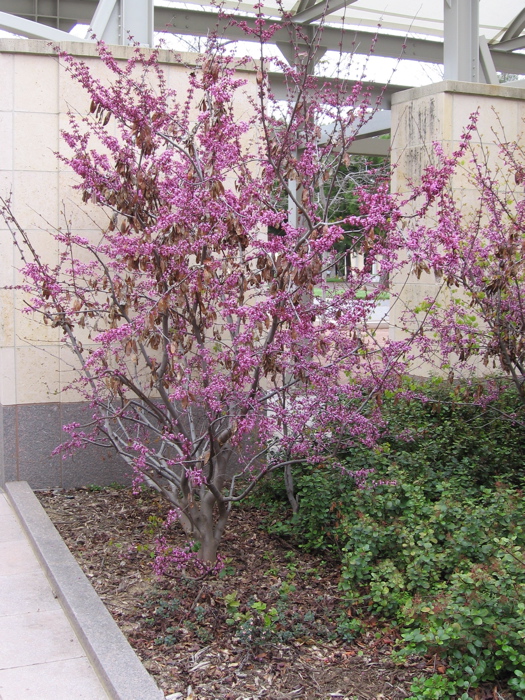Cercis occidentalis
 western redbud
western redbud
A multistemmed deciduous shrub or small tree, native to the Sierra foothills and elsewhere, with magenta flowers that appear in March before the leaves. The flower color alone distinguishes it at a glance from eastern redbud. Flat brown pods, which are still hanging on the tree when the flowers appear in March, contain a few hard, brown, shiny seeds that will take years to germinate unless soaked with boiling water. As boiling water is very rare in nature, this raises an interesting question.
There was a rare clump of four situated in the southwest corner of Santa Teresa Street and Lomita Drive; when the New Guinea sculpture garden was relandscaped in 1994 only one remained, but eastern redbuds were brought in as reinforcements. Western redbud also is at 300 Lowell Avenue, Palo Alto, to the right of the driveway. Just before 2000, dozens of California redbuds were planted in Lomita Mall east of and between the McCullough and Gordon and Betty Moore buildings. It is also growing in the California Native Garden as of 6 May 2006.
You can collect the hard smooth seeds by the hundreds; a bowl of them run through the fingers is at least as therapeutic as a string of worry beads.
Flowers are produced along the branches and trunk before leaves appear.
Illustrations: habit of young tree.
Name derivation: Greek name kerkis, probably for a poplar, but also applied to C. siliquastrum, which through confusion between Judas and Judaea, is now traditionally the tree on which Judas hanged himself; occidentalis – western. – William T. Stearn, Stearn’s Dictionary of Plant Names for Gardeners, Portland, OR.: Timber Press, 1996.
About this Entry: The main text of this entry is from the book Trees of Stanford and Environs, by Ronald Bracewell, published 2005. California garden location and note on pea family subsequently added by John Rawlings. Name derivation of genus from Stearn corrected (SP, Mar 2023).






